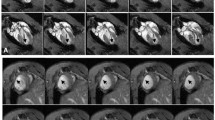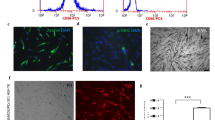Abstract
Purpose
Cell therapy using bone marrow mesenchymal stem cells (BMSCs) shows promise in the treatment of myocardial infarction (MI) but accurate cell delivery within MI areas remains critical. In the present study, we tested the feasibility of in vivo pinhole SPECT imaging for monitoring the sites of intramyocardial implanted BMSCs in relation to targeted MI areas in rats.
Methods
BMSCs were labelled with 111In-oxine and injected within the fibrotic areas of 3-month-old MI in ten rats. Two days later, dual 111In/99mTc-sestamibi pinhole SPECT was recorded for localisation of 111In-BMSCs on a 15-segment left ventricular (LV) division. Additional 99mTc-sestamibi pinhole SPECT had been performed 1 month earlier and on the day before transplantation. In vitro counting on histological sections was used to validate the pinhole SPECT determination of 111In-BMSC activity within LV segments.
Results
The underperfused MI area (segments with <70% uptake) was stable between the 99mTc-sestamibi SPECT study recorded at 1 month (4.6±1.9 segments) and at 1 day (4.7±2.3 segments) before transplantation. 111In-BMSCs were detected by dual-energy SPECT in 56 segments: 33 (59%) were underperfused MI segments but 23 (41%) were not (14 adjacent and nine remote segments). Finally, 111In-labelled BMSCs were not detected in 14 out of the 47 (30%) underperfused MI segments.
Conclusion
When BMSCs are injected within MI areas in rats, sites of early cell retention do not always match the targeted MI areas. The dual-energy pinhole SPECT technique may be used for monitoring the sites of early retention of implanted BMSCs and the data obtained may have critical importance when analysing the effects of cardiac cell therapy.





Similar content being viewed by others
References
Orlic D, Kajstura J, Chimenti S, Jakoniuk I, Anderson SM, Li B, et al. Bone marrow cells regenerate infarcted myocardium. Nature 2001;410(6829):701–705
Tran N, Li Y, Bertrand S, Bangratz S, Carteaux JP, Stoltz JF, et al. Autologous cell transplantation and cardiac tissue engineering: potential applications in heart failure. Biorheology 2003;40(1–3):411–415
Chiu RC. Bone-marrow stem cells as a source for cell therapy. Heart Fail Rev 2003;8(3):247–251
Strauer BE, Brehm M, Zeus T, Kostering M, Hernandez A, Sorg RV, et al. Repair of infarcted myocardium by autologous intracoronary mononuclear bone marrow cell transplantation in humans. Circulation 2002;106(15):1913–1918
Kinnaird T, Stabile E, Burnett MS, Lee CW, Barr S, Fuchs S, et al. Marrow-derived stromal cells express genes encoding a broad spectrum of arteriogenic cytokines and promote in vitro and in vivo arteriogenesis through paracrine mechanisms. Circ Res 2004;94(5):678–685
Kocher AA, Schuster MD, Szabolcs MJ, Takuma S, Burkhoff D, Wang J, et al. Neovascularization of ischemic myocardium by human bone-marrow-derived angioblasts prevents cardiomyocyte apoptosis, reduces remodeling and improves cardiac function. Nat Med 2001;7(4):430–436
Kajstura J, Rota M, Whang B, Cascapera S, Hosoda T, Bearzi C, et al. Bone marrow cells differentiate in cardiac cell lineages after infarction independently of cell fusion. Circ Res 2005;96(1):127–137
Mangi AA, Noiseux N, Kong D, He H, Rezvani M, Ingwall JS, et al. Mesenchymal stem cells modified with Akt prevent remodeling and restore performance of infarcted hearts. Nat Med 2003;9(9):1195–1201
Brenner W, Aicher A, Eckey T, Massoudi S, Zuhayra M, Koehl U, et al. 111In-labeled CD34+ hematopoietic progenitor cells in a rat myocardial infarction model. J Nucl Med 2004;45(3):512–518
Aicher A, Brenner W, Zuhayra M, Badorff C, Massoudi S, Assmus B, et al. Assessment of the tissue distribution of transplanted human endothelial progenitor cells by radioactive labeling. Circulation 2003;107(16):2134–2139
Chin BB, Nakamoto Y, Bulte JW, Pittenger MF, Wahl R, Kraitchman DL. 111In oxine labelled mesenchymal stem cell SPECT after intravenous administration in myocardial infarction. Nucl Med Commun 2003;24(11):1149–1154
Barbash IM, Chouraqui P, Baron J, Feinberg MS, Etzion S, Tessone A, et al. Systemic delivery of bone marrow-derived mesenchymal stem cells to the infarcted myocardium: feasibility, cell migration, and body distribution. Circulation 2003;108(7):863–868
Vanhove C, Lahoutte T, Defrise M, Bossuyt A, Franken PR. Reproducibility of left ventricular volume and ejection fraction measurements in rat using pinhole gated SPECT. Eur J Nucl Med Mol Imaging 2005;32(2):211–220
Maskali F, Poussier S, Marie PY, Tran N, Antunes L, Olivier P, et al. High-resolution simultaneous imaging of SPECT, PET, and MRI tracers on histologic sections of myocardial infarction. J Nucl Cardiol 2005;12(2):229–230
Tran N, Bertrand S, Li Y, Carteaux JP, Stoltz JF, Villemot JP. Beneficial hemodynamic effects of autologous bone marrow cell transplantation in rats with heart failure. Transplant Proc 2002;34(8):3262–3264
Vanhove C, Franken PR, Defrise M, Deconinck F, Bossuyt A. Reconstruction of gated myocardial perfusion SPET incorporating temporal information during iterative reconstruction. Eur J Nucl Med Mol Imaging 2002;29(4):465–472
Vanhove C, Defrise M, Franken PR, Everaert H, Deconinck F, Bossuyt A. Interest of the ordered subsets expectation maximization (OS-EM) algorithm in pinhole single-photon emission tomography reconstruction: a phantom study. Eur J Nucl Med 2000;27(2):140–146
Cerqueira MD, Weissman NJ, Dilsizian V, Jacobs AK, Kaul S, Laskey WK, et al. Standardized myocardial segmentation and nomenclature for tomographic imaging of the heart: a statement for healthcare professionals from the Cardiac Imaging Committee of the Council on Clinical Cardiology of the American Heart Association. Circulation 2002;105(4):539–542
Phinney DG, Kopen G, Isaacson RL, Prockop DJ. Plastic adherent stromal cells from the bone marrow of commonly used strains of inbred mice: variations in yield, growth, and differentiation. J Cell Biochem 1999;72(4):570–585
Tran N, Li Y, Maskali F, Antunes L, Laurens MH, Marie PY, et al. Short term heart retention and distribution of intramyocardial delivered mesenchymal cells within necrotic or intact myocardium. Cell Transplantation 2006;in press
Petzold R, Zeilhofer HF, Kalender WA. Rapid protyping technology in medicine—basics and applications. Comput Med Imaging Graph 1999;23(5):277–284
Salin H, Maitrejean S, Mallet J, Dumas S. Sensitive and quantitative co-detection of two mRNA species by double radioactive in situ hybridization. J Histochem Cytochem 2000;48(12):1587–1592
Olivares EL, Ribeiro VP, Werneck de Castro JP, Ribeiro KC, Mattos EC, Goldenberg RC, et al. Bone marrow stromal cells improve cardiac performance in healed infarcted rat hearts. Am J Physiol Heart Circ Physiol 2004;287(2):H464–H470
Miller TD, Christian TF, Hopfenspirger MR, Hodge DO, Gersh BJ, Gibbons RJ. Infarct size after acute myocardial infarction measured by quantitative tomographic 99mTc sestamibi imaging predicts subsequent mortality. Circulation 1995;92(3):334–341
van der Wall EE, Niemeyer MG, de Roos A, Bruschke AV, Pauwels EK. Infarct sizing by scintigraphic techniques and nuclear magnetic resonance imaging. Eur J Nucl Med 1990;17(1–2):83–90
Gibbons RJ, Miller TD, Christian TF. Infarct size measured by single photon emission computed tomographic imaging with 99mTc-sestamibi: a measure of the efficacy of therapy in acute myocardial infarction. Circulation 2000;101(1):101–108
Constantinesco A, Choquet P, Monassier L, Israel-Jost V, Mertz L. Assessment of left ventricular perfusion, volumes, and motion in mice using pinhole gated SPECT. J Nucl Med 2005;46(6):1005–1011
Pfeffer MA, Braunwald E. Ventricular enlargement following infarction is a modifiable process. Am J Cardiol 1991;68(14):127D–131D
Mulinari RA, Gavras I, Wang YX, Franco R, Gavras H. Effects of a vasopressin antagonist with combined antipressor and antiantidiuretic activities in rats with left ventricular dysfunction. Circulation 1990;81(1):308–311
Meoli DF, Sadeghi MM, Krassilnikova S, Bourke BN, Giordano FJ, Dione DP, et al. Noninvasive imaging of myocardial angiogenesis following experimental myocardial infarction. J Clin Invest 2004;113(12):1684–1691
Giles FJ, Waxman AD, Nguyen KN, Fuerst MP, Kusuanco DA, Franco MM, et al. Comparison of technetium-99m sestamibi and indium-111 octreotide imaging in a patient with Ewing’s sarcoma before and after stem cell transplantation. Cancer 1997;80(12 Suppl):2478–2483
Even-Sapir E, Keidar Z, Sachs J, Engel A, Bettman L, Gaitini D, et al. The new technology of combined transmission and emission tomography in evaluation of endocrine neoplasms. J Nucl Med 2001;42(7):998–1004
Zhou R, Thomas DH, Qiao H, Bal HS, Choi SR, Alavi A, et al. In vivo detection of stem cells grafted in infarcted rat myocardium. J Nucl Med 2005;46(5):816–822
Acknowledgements
This work was supported by grants from the French Society of Cardiology, the “Association Lorraine de Recherche et Transplantation” (ALERT), the ARISC association (Association for Research and Scientific Information in Cardiology) and the FDF foundation (Foundation of France for research on cardiovascular diseases). The authors thank Mrs T. Lacrouts and Mr. H. Boutley for their technical help.
Author information
Authors and Affiliations
Corresponding author
Rights and permissions
About this article
Cite this article
Tran, N., Poussier, S., Franken, P.R. et al. Feasibility of in vivo dual-energy myocardial SPECT for monitoring the distribution of transplanted cells in relation to the infarction site. Eur J Nucl Med Mol Imaging 33, 709–715 (2006). https://doi.org/10.1007/s00259-006-0075-9
Received:
Accepted:
Published:
Issue Date:
DOI: https://doi.org/10.1007/s00259-006-0075-9




